“Birding is a fascinating, exciting, challenging game. It requires and encourages ever-growing skill. It may involve us in great adventures and wide travel, sometimes in difficult terrain. Seeking new birds to check off on our life lists may draw us further into the lives of these birds, challenging us to learn more about their life cycles, their behaviors, and ecology; and as our ecological perspectives expand, we may be stimulated to become more involved in conservation work, to protect the habitats of the many species we enjoy.” (Burton S. Guttman, Birding, February 2004)
Yes, birds are beautiful, so mobile, so visible, but not the only things that make birding fun. While birds are the objective of any "birding" expedition, they only open a small window on what lies out there on the wild side.
One cloudy morning in early December, the dew point was high and the air very still when we walked out on the wetlands adjacent to our south Florida home. Viewed from our patio a little before sunrise, the sky looked ominous..

Some of my early morning photos had not been as sharp as I expected, and I had an "Aha!" moment when I noticed the fog covering my camera lens.The camera had spent the night in air-conditioned comfort. Warm, moist air had kissed the cold glass. My microfiber lens cloth came in handy, and I did much better after that. The first test of the fog-free lens was this image of watery pearls that festooned the spider silk.

Tall blades of grass, weighed down by the dew, drooped over the trail.

That morning we almost scrubbed our walk in our local wetlands birding patch. Mary Lou woke up not feeling 100% and suggested I go on without her. She knows how much I like getting out, and either she started recovering rapidly, or, more likely felt bad for me, for she soon said she thought the cool morning air might be good for her. Once having decided to go out, she wasted no time getting dressed, and had to wait for me. Usually we are out about a half hour before sunrise, but this morning it was 7:25 AM before we left the house and started down the gravel road that leads into the wetlands. I didn't know it, but we were in for a big surprise.
The day before, I had gotten some pretty images of a female Prairie Warbler as she foraged for insects among the ripening berries of an exotic Brazilian Pepper.
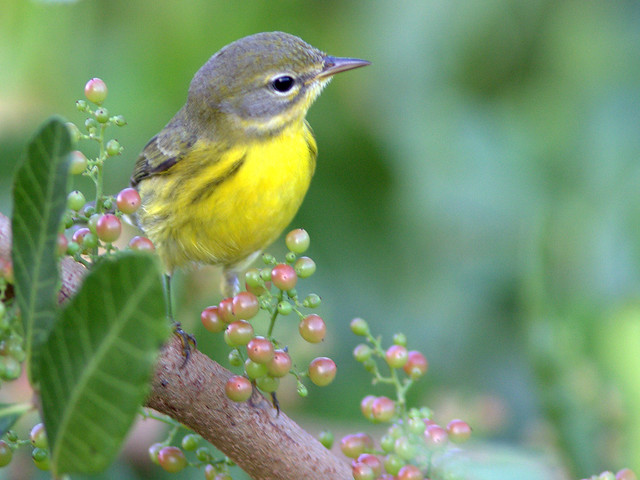
The warbler looked so small and delicate.
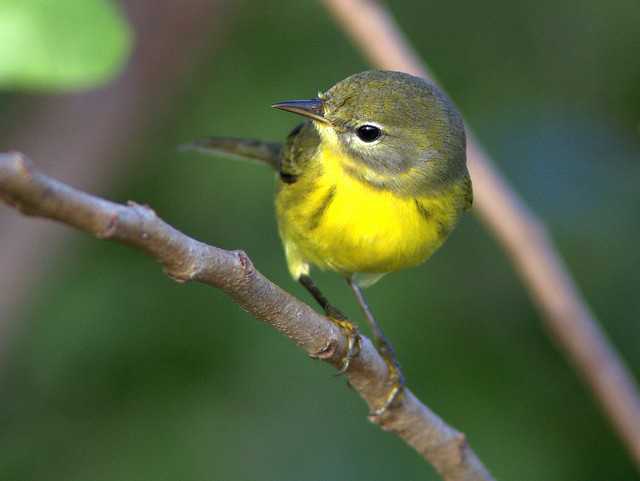
Palm Warblers were everywhere.

I could tell from his red eyes that this Eastern Towhee had migrated in, as our locals have yellow or whitish eyes.
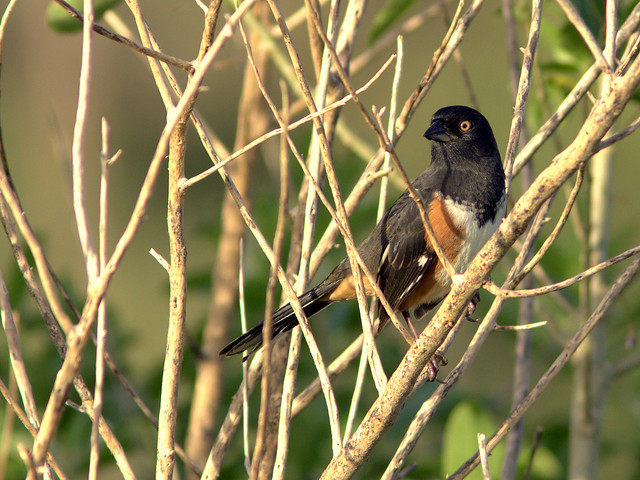
This Eastern Towhee exhibited the familiar white eyes of the southern subspecies.

A White-eyed Vireo stared out between the branches of a small shrub.
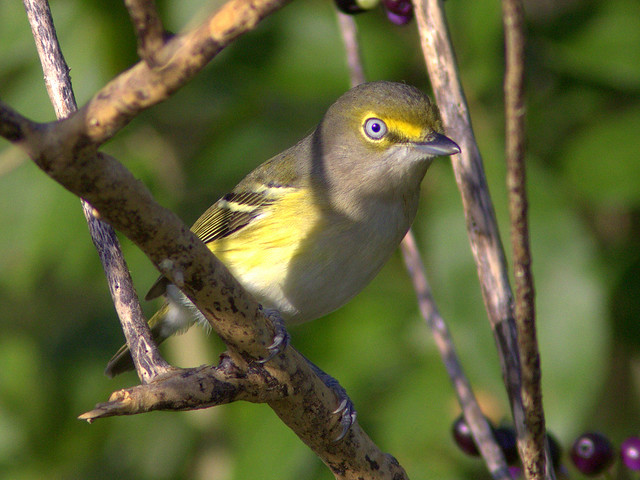
A Common Ground-Dove looked down from a safe perch.
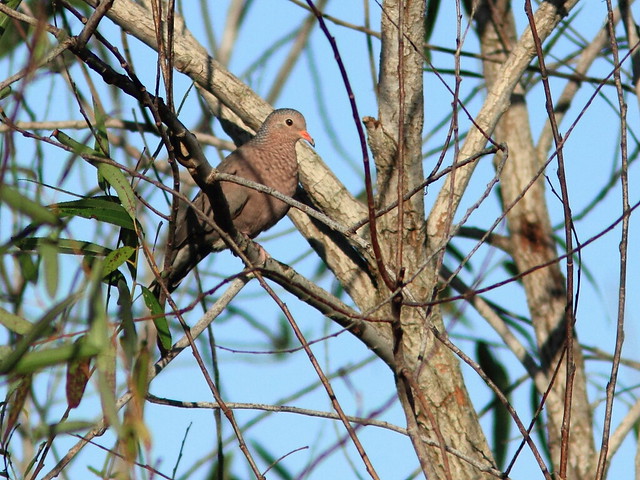
We sometimes get fleeting looks at Bobcats on our bird walks, usually only if we are out very early. This morning, despite the later hour, we decided to check out the area where we usually had seen them. We reached the intersection of the gravel road and the two-track path that runs south along the SW 196th Avenue Levee. Except for the portion of the path nearest the road, Water District maintenance crews had mowed the entire top of the levee and pulled up all the trees and shrubs on either side, moving them down the slope opposite the canal, to the west. This opened up the sight distance in a straight line for about a mile south to the Miami-Dade County Line. This was great for photography, as intervening vegetation had hampered our earlier attempts to photograph the Bobcats as they hunted for rabbits along the trail. The downside was that the lack of cover made it almost impossible for us to hide along the way.
We walked the first 50 feet or so through high grass, almost to the open part of the path, and checked to see if any Bobcats might be visible. At first we saw nothing, but suddenly the shapes of at least two mammals appeared. At 400 or more yards, the binocular view was barely adequate to identify them as Bobcats. They were very active, running back and forth across the trail. A larger Bobcat then emerged. Now I realized that she was the parent and they were her two mischievous cubs, much too far away for my camera to pick up much more than their silhouettes. The two cubs engaged in playful combat.

Sometimes all three disappeared into the trail-side cover, only to re-emerge into plain sight on the trail. I took advantage of this by moving out of the secluded area unto the path, where I did my best to stay far over on the side of the open swath, to help conceal my profile. Satisfied with the distant views, Mary Lou continued back on her walk without me. In small stages I moved nearer to the cats, getting to within about 50 yards. I took over 400 photos in the space of an hour. A Northern Harrier, the first I'd seen this season, flew up from the trail in front of me and passed right over the Bobcats.

To my surprise, the two Bobcats starting walking towards me, an adult on the right and a nearly full-grown cub on the left. At this point, I had to stand perfectly still in full view, in the center of the path, holding eight pounds of camera gear up to my face. Only about 50 yards away, they stared at me, maybe trying to figure out who or what I was:
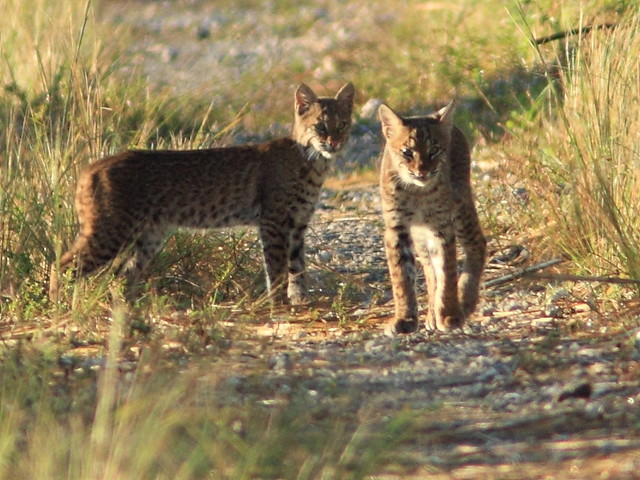
The second cub appeared behind them, and the adult sat down and waited for it to join them. The second cub was noticeably smaller. By now, my camera felt like it weighed a ton.

The smaller cub walked over to the left side of the trail:...
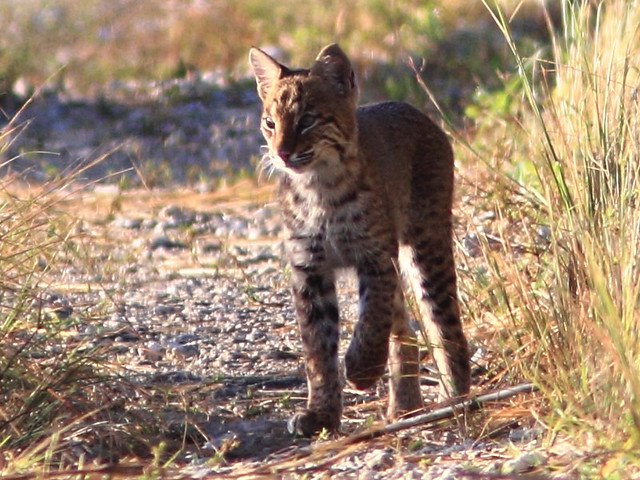
...and looked into the brush that bordered the canal.
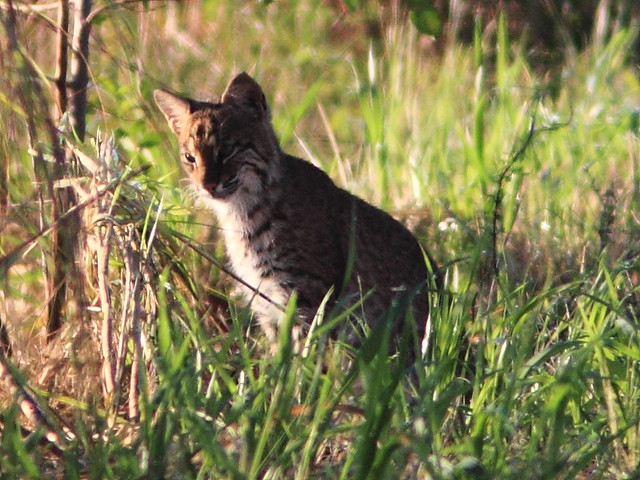
Flash forward a couple of weeks to one morning just before Christmas. Forgive me, but I did say that "Birding is fun." This is still a blog about "birding," but while it was too dark for birds, I was single-minded in my pursuit of Bobcats. We got out early, and it was about 15 minutes before sunrise when we stopped to check out the usual spot for Bobcats. We immediately saw three, far ahead to the south on the levee path. It was the same adult female with her two half-grown cubs. Mary Lou again left me to resume more conventional "birding," knowing I would remain uncommunicative and glued to my camera as long as Bobcats were in sight. I stalked closer to the cats. To my advantage, there was a slight SE breeze in my face. The adult cat was concentrating on the cubs, which had disappeared into the grass to the left. I walked a few steps and then took a shot. I reached a point about 40 yards from the adult, then moved out into the path to get a clear shot.

She was intent on watching the cubs, so I moved a bit nearer. Suddenly she turned and saw me, and began watching me intently. I froze, out in the open.

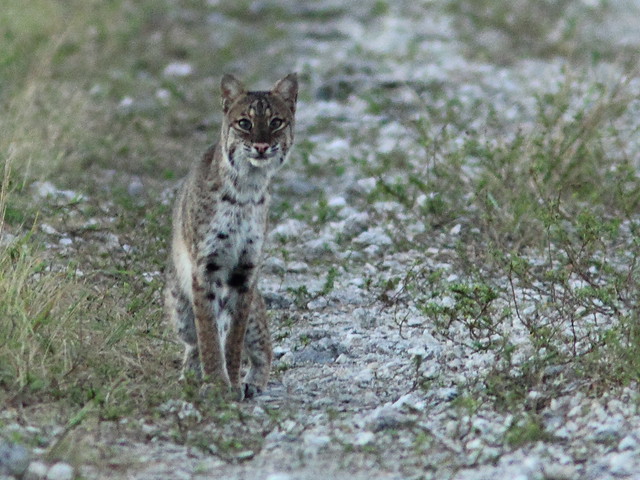
She stood up and then walked diagonally in my direction before rather purposefully disappearing into the brush while continuing towards me.



A House Wren began chattering near her position. Soon the wren, or another, began scolding more to my right. In the meantime, the larger cub had emerged onto the trail and was sitting on the path just staring in my direction. The cub finally began to look alarmed and ran off into the high grasses of the expansive wetlands to the right.
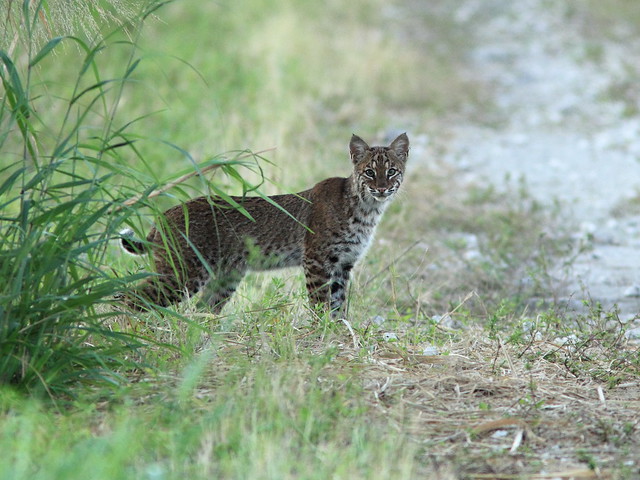
Meanwhile, the chattering of the wren started coming from just alongside me, then moved a bit behind me to my right. I assumed that the parent Bobcat was checking me out, but I could not see or hear any sign of her. If she were a panther, I would have been very anxious about coming between her and the cubs. Then, the second, smaller of the two cubs startled me by walking out on the path, only about 25-30 feet in front of me.
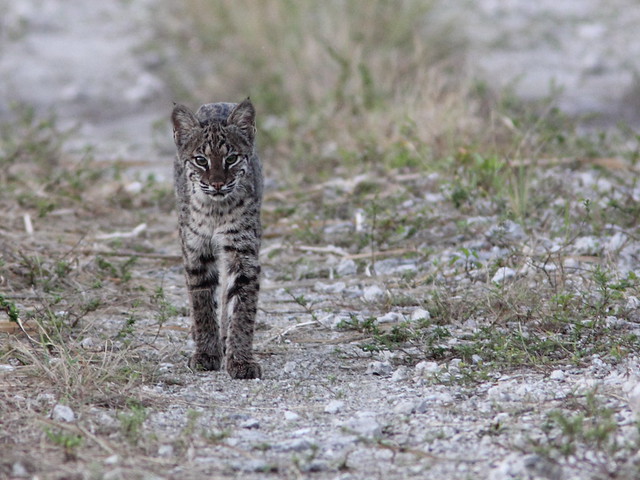
The smaller cub looked back towards where its larger litter-mate had disappeared into the brush.

It stepped slowly towards me and stopped. For a while it seemed to be looking past me.
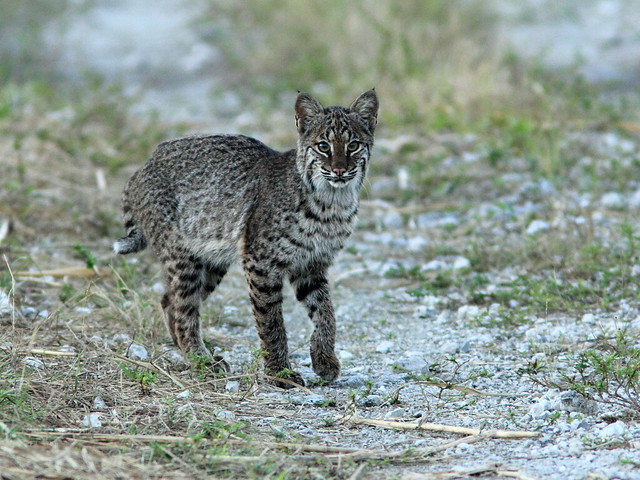
I'll admit that the hair stood up on the back of my neck, and the suspense was too much, so I turned my head to see if the mother had moved onto the path behind me. I did not see her, but my movement scared the cub and it twitched its tail before running off.
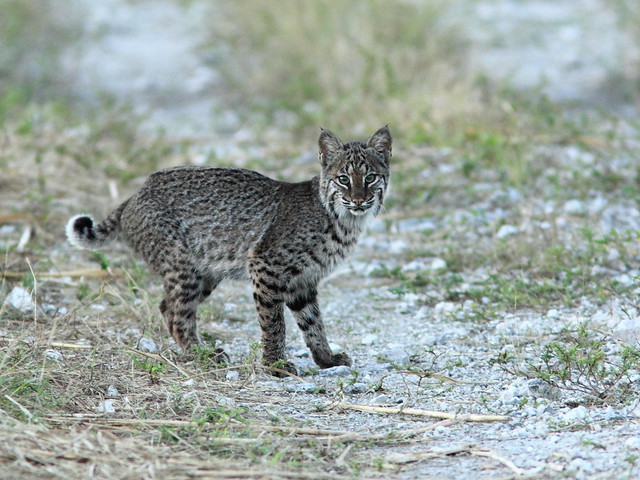

Searchable index to earlier ROSYFINCH RAMBLINGS posts


A wonderful post Ken, great story that had me on the edge of my seat. While birds are my primary focus in photography it is getting out into nature among them, the animals and natural settings that soothes my spirit. It's all good.
ReplyDeleteFantastic post Ken, felt my skin tingling too. As Mia says, I think all of nature is wonderful and what a blessing to be able to observe the cats so closely. Love the White Eyed Vireo especially.
ReplyDeletedan
A great post Ken with some amazing photos to go with it.
ReplyDeleteNice! Never know what you'll run into while birding!
ReplyDeleteQuite and adventure. The birds were just an appetizer on this morning, but if they're out and about and comfortable, then who knows what else will be on the trails. Lovely photos and commentary,
ReplyDeleteBobcat-ing is fun too! Very cool post Ken and nice photography.
ReplyDeleteJust discovered you through Kelly at Red and the Peanut. What a great site you've got here, and this post reads like a suspenseful novel, beautifully illustrated. I'll be back!
ReplyDeleteLovely photos! It looks like you had a great day.
ReplyDeleteWhat an adventure!! We have some here in Sweden, not so many though. But you never see them. Great pictures! Congratulations!
ReplyDeleteThat is an adventure!!!! Love bobcats. Had the same thing happen to me on Sunday night this past weekend. But my lense was up in the air and it was the long one. The Bobcat came right up to me and I just watched it. Amazing. People asked, "Weren't you scared?" No. They don't frighten me for some reason. However, if it were a mountain lion that would be a different story. Your shots are gorgeous.....absolutely incredible. The thing is....yes, a post can be about birds or we can look for birds, etc, but it's also about the other random things that happen on these outings....like the bobcat. And that's also very exciting. I'm glad you shared the photos. Really impressive quick hand there. What an opportunity! Have a good weekend.
ReplyDeleteYou never know what glorious sights you will come across while birding. What a fabulous adventure! Those Bobcats are certainly stunning creatures! Love the little black ear tips. Fantastic photographs! Stunning captures of the beautiful birds, too! Quite an amazing experience for you.
ReplyDeleteOh my gosh Dan-I'm in awe! Amazing shots and what a thrilling experience that must have been!
ReplyDeleteQuem me dera viver esse momento, no entanto reconheço que dá para levantar cabelo. Valem as imagens pela aventura. É uma sorte encontrar estes linces aqui em Portugal, só em reservas, pois os caçadores matam tudo que meche e é belo.
ReplyDeleteNeste inverno seco e frio, não tenho aves para retratar. Ainda bem e fico feliz por haver locais como esses, onde se preserva o que é de todos.
Bos fotos.
Abraço